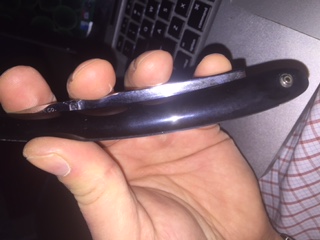Results 1 to 9 of 9
Thread: scales are discolored
-
12-30-2016, 08:04 PM #1Senior Member

- Join Date
- Oct 2015
- Location
- Pittsburgh, PA
- Posts
- 212
Thanked: 21 scales are discolored
scales are discolored
Hi all,
So I purchased this razor at an antique shop. The blade looked to be in good condition, and I knew the scales needed a bit of help, but could be salvaged - or so I thought. Looked like just some soap spots, and just old age perhaps. Nothing a little elbow grease can't handle...
Anyway, I got it home, polished the blade, and took a bit of MAAS to the scales. Suddenly, it appears the one scale is way off color. In addition, the scales have an odd smell. Like burnt rubber. I've never had issues with using MAAS on scales before. Now I'm wondering if the scales are off gassing, or if the MAAS affected the one scale. Which would be strange b/c the other scale seems unaffected.
The razor itself doesn't show signs of cell rot. So I'm left wondering what the issue might be?
[ATTACH=CONFIG]253326[/ATTACH

Last edited by relli1130; 12-30-2016 at 08:12 PM.
-
12-30-2016, 08:13 PM #2Senior Member



- Join Date
- Mar 2012
- Location
- Thunder Bay, Ontario, Canada
- Posts
- 17,334
Thanked: 3228
I am guessing the scales are made of vulcanite, a hard black vulcanized rubber. The scales probably now have a brownish tinge and smell like Sulphur. I would rub them down with some glycerin and see if that helps.
You can do a site search under "vulcanite scales" for more info and ideas.
BobLife is a terminal illness in the end
-
12-30-2016, 08:36 PM #3

Definitely appear to be Vulcanite. The smell is most likely due to fresh surface oxidation being exposed by the polishing. You can use very fine wet/dry sandpaper if you like (I always unpin and wet sand), or you can keep at it with the Maas polish. Once you are through the oxidation, they will be shiny black and virtually odorless. I use a little carnauba wax after polishing to help protect the surface and slow the onset of oxidation.
"Every normal man must be tempted at times to spit on his hands, hoist the black flag, and begin to slit throats." -H. L. Mencken
-
12-30-2016, 08:38 PM #4Senior Member

- Join Date
- Oct 2015
- Location
- Pittsburgh, PA
- Posts
- 212
Thanked: 21
Thanks for the advice. I hit them with wet/dry 1000 grit wet sanded. Left with a light/dull finish. A bit of MAAS didn't seem to help. Might try the wax, or keep at it with the 1000 grit for a while
-
12-30-2016, 08:41 PM #5

I usually go up to 1500 or 2000 grit and then hit them with plastic compound on an unstitched cotton wheel at medium speed.
"Every normal man must be tempted at times to spit on his hands, hoist the black flag, and begin to slit throats." -H. L. Mencken
-
12-30-2016, 08:46 PM #6

If you can find info about buffing tobacco pipe stems, that is the same stuff they used on the older pipes. Some still use it nowadays.
 Be careful how you treat people on your way up, you may meet them again on your way back down.
Be careful how you treat people on your way up, you may meet them again on your way back down.
-
12-31-2016, 11:33 PM #7Senior Member

- Join Date
- Oct 2015
- Location
- Switzerland
- Posts
- 104
Thanked: 52
these scales are made from vulcanite/ebonite, a kind of rubber with a very high content of sulphur. when exposed to daylight/sunlight/UV the material oxidizes and changes its colour to a greenish brown.
from wikipedia ("ebonite"):
Under the influence of the ultraviolet portion in daylight hard rubber oxidizes and exposure to moisture bonds water with free sulfur on the surface creating sulfates and sulfuric acid at the surface that are very hygroscopic. The sulfates condense water from the air, forming a hydrophilic film with favorable wettability characteristics on the surface.[6] These aging processes will gradually discolor the surface grayish green to brown and cause rapid deterioration of electric surface resistivity.
the sulphuric acid is aggressive and will eventually damage the steel. so keep razors with ebonite scales in the dark to save them from a slow death...
regards,
hans
-
01-01-2017, 05:37 AM #8

In my experience Ebonite does well with sanding up to 1k or 1.5k and finished with some white rouge. The more aggressive rouges leave a kind of cloudy finish but the white gets them glossy black. Keep them moving on the wheel to avoid heating them up and causing more oxidation. They don't seem to like hot water or dish soap either. I would also avoid metal polishes with solvents in them.
B.J.
-
01-01-2017, 12:40 PM #9Senior Member



- Join Date
- Apr 2012
- Location
- Diamond Bar, CA
- Posts
- 6,553
Thanked: 3215
Yup, also known as Gutta Percha. 000 steel wool and Mr Clean Magic Eraser, Green and White compound will get them gleaming.
I use a worn 600 grit greaseless on a sewn cotton wheel to remove the oxidized, then buff with green greased and finish on white compound. Also works great on pipes and stems.
If doing by hand, 000 steel wool, rubbing compound or 600 and 1k wet and dry, finish with Novus Plastic polish. They will turn black again once the oxidation is removed.


 1Likes
1Likes LinkBack URL
LinkBack URL About LinkBacks
About LinkBacks






 Reply With Quote
Reply With Quote

